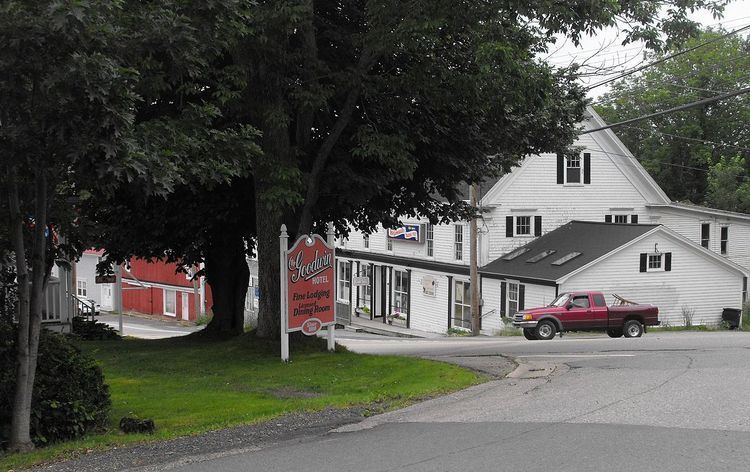Founded 1783 | Time zone ATS Local time Saturday 12:28 PM | |
 | ||
Weather 6°C, Wind E at 24 km/h, 48% Humidity | ||
Drive through weymouth nova scotia
Weymouth is a rural village located in Digby County, Nova Scotia on the Sissiboo River near its terminus on Baie Ste. Marie.
Contents
- Drive through weymouth nova scotia
- Map of Weymouth NS Canada
- History
- Disasters
- New France Electric City
- Geography
- Economy
- Demographics
- Weymouth in fiction
- References
Map of Weymouth, NS, Canada
History
The area was settled in the 1760s by New England Planters following the Acadian Expulsion. The town was formally founded by Loyalists in 1783 (the year that the Treaty of Paris was signed to end the American Revolution). Current-day Weymouth was once called Weymouth Bridge, and Weymouth North was called Weymouth. Weymouth is supposed to have been named in honour of the previous settlement of the Strickland family from Weymouth, Massachusetts.
Shipping and shipbuilding were the main industry in the mid-19th century. Remnants of docks can be seen on the Northeast side of the Sissiboo today. Goods such as lumber were loaded on ships at these docks and shipped all over the world. Until recently, Weymouth housed the oldest general store in Eastern Canada. Opened in 1837, the store was called The Trading Post, but closed in 2009. The village also houses one of the original offices of the Merchants Bank of Halifax (later renamed Royal Bank of Canada). This building is now part of the aforementioned Weymouth Trading Post building. The Dominion Atlantic Railway stopped running through Weymouth in March 1990.
Nearby Weymouth Falls was home to one of the world's greatest boxers, Sam Langford (1886–1956). Although he was never officially crowned World Champion, he held titles from England, Spain and Mexico.
Disasters
On 4 August 1909, 2 churches, a hotel, and several other buildings were destroyed by fire. On 2 October 1929 a fire started in the general store of Captain R.D. Barkhouse and swept through the downtown area destroying 25 buildings including retail shops, factories, and private homes. It was estimated that the fire caused approximately $250,000 in damages. No serious injuries or deaths occurred because of the fire. On 6 February 1958, another fire destroyed the boat and furniture plants of Weymouth Industries Ltd., and in June 1959 six businesses were wiped out due to fire.
The Sissiboo River overflowed in March 2003, flooding the town under almost two feet of water.
New France ("Electric City")
The lumber community of New France, located about 12 miles (19 km) inland from Weymouth, was founded by the Stehelin family who came to the area from Normandy, France in 1892. The community they established was notable for its early use of hydroelectric power generation, earning it the local nickname "The Electric City". Also notable was the Stehelin family's railroad, the Weymouth and New France Railway, constructed using logs as tracks, which they used to bring lumber to the company wharf at Weymouth. As many as 1.5 million board feet of timber were shipped annually from New France to South America and England. The railway was destroyed by fire in 1907 and the business ceased not long afterwards. There is little left of New France except for the foundations of the city buildings. J.D. Irving, recent owners of the land, established walking trails and interpretive signs at the site and fixed the foundations so they are safe for visitors to explore. The lands were purchased by the Province of Nova Scotia on 3 February 2010, thus assuring the protection of this unusual part of the province.
Geography
Modern day Weymouth straddles the Sissiboo River. This river swells approximately every six hours as salt water backs up from the high tides of the Bay of Fundy into St. Mary's Bay.
Weymouth is situated on the border between the provincial electoral districts of Clare and Digby-Annapolis. It is located 33 kilometres from Digby, 72 kilometres from Yarmouth and 250 kilometres from the capital of Nova Scotia, Halifax.
Smaller villages surrounding Weymouth proper are Weymouth Falls, Weaver Settlement, Ohio, Southville, Riverdale, Danvers, Hassett, Saint Bernard and New Edinburgh.
Two exits (27 and 28) on Highway 101 are the primary access to the town. Trunk 1 runs through the village and was the main thoroughfare from the Annapolis Valley to Yarmouth prior to the construction of Highway 101.
Economy
Fur farming, especially mink, fishing, and logging are the principle industries in the area.
Demographics
The Village of Weymouth comprises many different ethnic backgrounds. Primarily populated by descendants of the loyalists, African-Canadian and White, it also is home to a few Acadians, Mi'kmaq and people of German ancestry.
Weymouth in fiction
Author Josephine Leslie (pseudonym R. A. Dick) frequently summer vacationed in Weymouth North. During her visits she would imagine living during Weymouth's heyday (age of sail) and was inspired to write "The Ghost and Mrs. Muir".
Weymouth and Weymouth Falls appear mythologized in George Elliott Clarke's poetical work Whylah Falls (1990).
